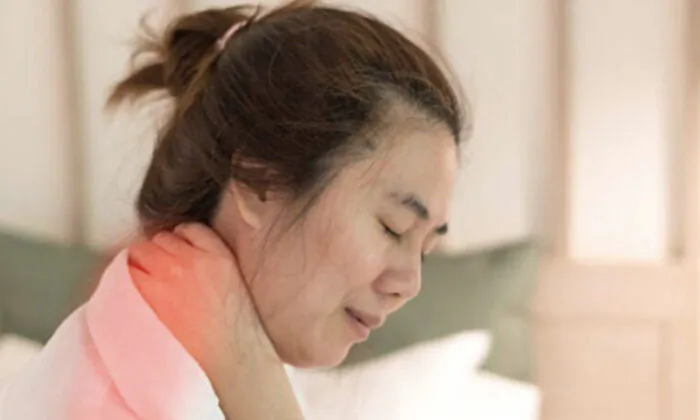Dowager’s Hump, also commonly known as “cervical vertebra bag,” or “buffalo shoulder,” is a forward rounding in the upper part of the spine. When some people bow their heads, there is a mass bulging somewhere between the intersection of the upper spinal cord and the neck. This is commonly called Dowager’s Hump.
From an anatomical point of view, “Dowager’s Hump” refers to the protrusions in the sixth cervical vertebrae to the third thoracic vertebrae. The main reason for the occurrence of Dowager’s Hump is the habit of prolonged and/or repeated tilting the head forward.
Common actions that fit such malaises are lowering the head to work, looking down at your phone, and the like. These habits are common with our modern lifestyles, so perhaps it is unsurprising that more and more people are found to suffer from Dowager’s Hump.
Symptoms of Dowager’s Hump
Leaning the head forward or bowing the head will cause the muscles in the back of the neck becoming tense and stiff. The concentrated pressure on the junction of the cervical and thoracic vertebrae will cause chronic inflammation and swelling, and even local fat accumulation.
When the joints at this position are stuck, it will not only cause local nerve compression, but even extends up to the head and down to the upper back, which can bring about a few likely symptoms.
These include numbness in the hands, shoulder and back pain, cervical pain, headache, head distention, dizziness, tinnitus, sore eyes, earlier vision deterioration, sleep disturbance, palpitations, chest tightness, and the like.
Therefore, the Dowager’s Hump (cervical vertebra bag) is not just a matter of poor appearance, but its many related symptoms and illnesses that may crop up can be painful and become chronic.
Does Dowager’s Hump Only Occur in Fat People?
The main reason for Dowager’s Hump is the habit of leaning forward or bowing the head. It has nothing to do with being fat or thin. It is just that the fat on the back of the neck of obese people is easier to accumulate. The hump will therefore be more obvious, and the corresponding symptoms and illness that might occur will also be correspondingly more serious.
Alleviate the Symptoms via Proper Diet
In this respect, you can eat more natto, red yeast rice, turmeric, and vinegar-rich drinks to help reduce fat, remove blood stasis. It is good to soften the stiff muscles at the back of the neck and reduce excessive fat accumulation, thereby improving blood circulation and general metabolism.
7 Exercises That Help Fix Dowager’s Hump
1. Raise your chest and hold your chin back
People with Dowager’s Hump are likely to be those who are accustomed to leaning their heads forward, so the first action to improve is to do the reverse by raising the chest and hold the chin back.
2. Emulate swimming, butterfly style
- Straighten both arms horizontally, palms down, grasp the five fingers like the eagle claws, and rotate both arms and shoulder blades like swimming in butterfly style. Do it 10 times from back, then up and to the front.
- Straighten both arms horizontally, twist the palms upwards, and do the same from back, then up and to the front 10 times.
Note: The key to this action is to rotate the scapula from back, then up and then to the front. This action can instantly loosen the muscles of the neck, shoulders, and upper back. It will feel quite sore on the first try, but it is highly effective.
3. Lay the head backwards and then swing it to left and right
After doing the above butterfly swimming emulation, the muscles, and ligaments around the sixth cervical vertebrae to the third thoracic vertebrae should have been loosened.
- At this time, tilt the head back, look straight ahead with both eyes, and swing the head left and right 10 times to open the articular surface of the C6-C7 vertebrae of the cervical vertebrae.
Note: The combination of the exercises 2 and 3 can effectively improve the symptoms of hand numbness caused by the compression of the C6-C7 vertebrae of the cervical spine.
4. Reverse stretching the shoulder and neck 10 times
- Put the fingers of the right palm on the junction of the left neck and shoulder, pull it forward with force, and rotate the left shoulder back 10 times.
- After doing the first step, keep the left shoulder at rest, continue to push the fingers of the right palm forward, and rotate the head left and right 10 times.
- Repeat the first and second steps, this time with the left fingers of the left palm to the junction of the right neck and shoulder.
Note: This action can effectively alleviate the local stiffness of the muscles and ligaments around the cervical spine.
5. Put your hands together and draw a big circle
- Put your hands together in front of your chest, straighten your arms up, turn your palms forward, and draw a big circle to your sides. Repeat 10 times.
Note: This action can relax the tight muscles and ligaments in the upper back and improve the symptoms of shortness of breath associated with palpitations and chest tightness.
6. Lean back and stretch your arms
- With one foot in front and the other behind of you, stretch your arms straight up, and at the same time turn your palms out. At the same time, tilt the head slightly backward.
- Change the position of the feet and repeat 10 times.
Note:
- Both arms should be placed just close to the ears, do not open too far.
- This action helps to increase the lymphatic circulation under the armpits on both sides, alleviate the hunchback, and increase the lung capacity too.
- Almost all people with Dowager’s Hump also show symptoms of hunchback. Therefore, this action is worth doing to improve both.
7. Turn the head, shake the shoulders, and stretching both
- Lie on the bed face down, prop up the upper body with both elbows, keep the cervical spine parallel to the ground, and gently and slowly nod and turn the head. During the rotation, if you feel a sore spot, stop at that position for 10 seconds; then increase the rotation angle a little and hold for another 10 seconds; increase the rotation angle again for 10 more seconds. In this way, the point where the cervical vertebra is stuck will slowly loosen!
- Move both shoulders up and down in turn towards the head and repeat 20 times. This action can effectively open the stuck (displaced) thoracic spine and improve the symptoms of palpitations and chest tightness.
For the detailed action demonstration below, please watch the full program:
Epoch Health articles are for informational purposes and are not a substitute for individualized medical advice. Please consult a trusted professional for personal medical advice, diagnoses, and treatment. Have a question? Email us at HealthReporter@epochtimes.nyc




